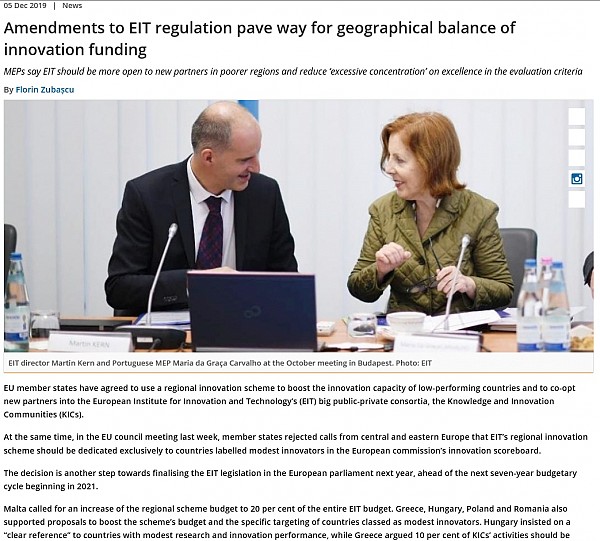Press Amendments to EIT regulation pave way for geographical balance of innovation funding
MEPs say EIT should be more open to new partners in poorer regions and reduce ‘excessive concentration’ on excellence in the evaluation criteria
By Florin Zubașcu
EU member states have agreed to use a regional innovation scheme to boost the innovation capacity of low-performing countries and to co-opt new partners into the European Institute for Innovation and Technology’s (EIT) big public-private consortia, the Knowledge and Innovation Communities (KICs).
At the same time, in the EU council meeting last week, member states rejected calls from central and eastern Europe that EIT’s regional innovation scheme should be dedicated exclusively to countries labelled modest innovators in the European commission’s innovation scoreboard.
The decision is another step towards finalising the EIT legislation in the European parliament next year, ahead of the next seven-year budgetary cycle beginning in 2021.
Malta called for an increase of the regional scheme budget to 20 per cent of the entire EIT budget. Greece, Hungary, Poland and Romania also supported proposals to boost the scheme’s budget and the specific targeting of countries classed as modest innovators. Hungary insisted on a “clear reference” to countries with modest research and innovation performance, while Greece argued 10 per cent of KICs’ activities should be concentrated in low performing countries.
Portuguese MEP Maria da Graça Carvalho, one of two leaders on EIT legislation in the European Parliament previously said the KICs should be more open to new members joining them, including non-EU members, if suitably qualified and able to pay their own way.
“We want a more balanced geographical distribution, but keeping excellence as the main criteria,” Carvalho said in a meeting of the parliament’s industry committee this week.
The other EIT rapporteur, Portuguese MEP Marisa Matias said the KICs should be more open to partners in poorer regions and reduce “excessive concentration” on excellence in the evaluation of new partners. “It’s important for the KICs to be focused more on greater openness,” Matias said.
On Wednesday the EIT announced a budget of €500 million for its eight KICs in 2020 and an additional €30 million for the regional innovation scheme for “concrete activities that will improve innovation capacities and link local ecosystems,” Adam Rottenbacher, head of director’s office at the EIT told Science|Business.
At the moment, the EIT cannot predict what will happen with its budget and the regional innovation scheme after 2020 and whether its budget will be higher because budget negotiations are still ongoing, with member states locking horns over how much of their national income to send to Brussels and on what projects will the money be spent. “We are not in position to comment,” said Rottenbacher.
Concerns on progress
In October, a delegation of MEPs led by Carvalho paid a visit to EIT headquarters in Budapest to assess the work done by the EIT after a critical report published in 2016 by the European Court of Auditors (ECA) said the EIT cannot become an effective tool for breeding innovation in the EU without “significant legislative and operational adjustments.”
Carvalho said the EIT should work towards establishing clearer synergies with other aspects of the Horizon programme. “I had the feeling the EIT was isolated from other parts of [research and innovation] in the commission,” she said.
Another point of concern is the sustainability of the KICs, which were initially designed to become independent of EIT funding after 15 years of operation. The three KICs established first are now reaching the end of their lifespan and MEPs are worried about their ability to carry on without money from the EU, as there is no effective mechanism in place for a sustainable phasing out of EU funding.
“It is a pity that we do not see a phasing out,” said Carvalho. “We would like to establish a model for financial sustainability of KICs.”
In the council meeting last week, Denmark voiced its concern over the EIT’s ability to continue supporting current KICs and adding new ones. In addition to the eight KICs it is running at the moment, the EIT has plans to establish two more.
The first EIT unicorn
Rottenbacher said the EIT is “definitely proud” of the improvements it has made since the audit. The EIT presented to the MEPs its biggest and most recent success: Northvolt, the first €1 billion company to come out of the EIT.
Founded by Peter Carlsson, a former executive at the US electric car maker Tesla, Northvolt was helped by the EIT and its energy KIC to secure a €350 million loan from the European Investment Bank to build a lithium-ion battery factory in Sweden. As a result, Volkswagen invested €900 million in June, boosting the company to a market valuation of over €1 billion.
“It’s a story that we think embodies the EIT’s potential,” Rottenbacher said.
In 2020, the EIT plans to power 1,000 start-ups and scale-ups and launch more than 360 new products and services. EIT also estimates next year its ventures could raise over €400 million in external capital.
